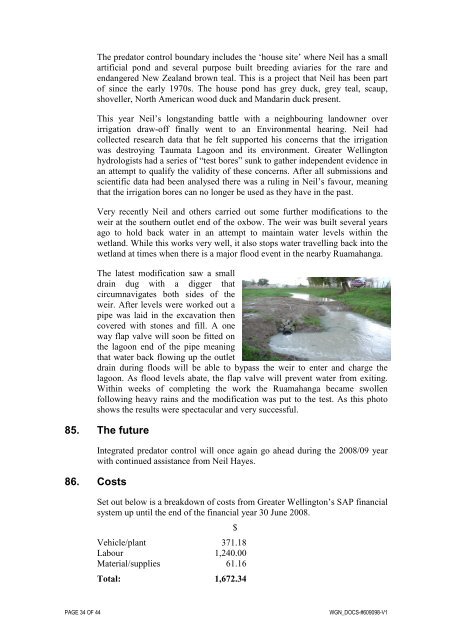Wairarapa Key Native Ecosystem Management Areas - Greater ...
Wairarapa Key Native Ecosystem Management Areas - Greater ...
Wairarapa Key Native Ecosystem Management Areas - Greater ...
Create successful ePaper yourself
Turn your PDF publications into a flip-book with our unique Google optimized e-Paper software.
The predator control boundary includes the ‘house site’ where Neil has a small<br />
artificial pond and several purpose built breeding aviaries for the rare and<br />
endangered New Zealand brown teal. This is a project that Neil has been part<br />
of since the early 1970s. The house pond has grey duck, grey teal, scaup,<br />
shoveller, North American wood duck and Mandarin duck present.<br />
This year Neil’s longstanding battle with a neighbouring landowner over<br />
irrigation draw-off finally went to an Environmental hearing. Neil had<br />
collected research data that he felt supported his concerns that the irrigation<br />
was destroying Taumata Lagoon and its environment. <strong>Greater</strong> Wellington<br />
hydrologists had a series of “test bores” sunk to gather independent evidence in<br />
an attempt to qualify the validity of these concerns. After all submissions and<br />
scientific data had been analysed there was a ruling in Neil’s favour, meaning<br />
that the irrigation bores can no longer be used as they have in the past.<br />
Very recently Neil and others carried out some further modifications to the<br />
weir at the southern outlet end of the oxbow. The weir was built several years<br />
ago to hold back water in an attempt to maintain water levels within the<br />
wetland. While this works very well, it also stops water travelling back into the<br />
wetland at times when there is a major flood event in the nearby Ruamahanga.<br />
The latest modification saw a small<br />
drain dug with a digger that<br />
circumnavigates both sides of the<br />
weir. After levels were worked out a<br />
pipe was laid in the excavation then<br />
covered with stones and fill. A one<br />
way flap valve will soon be fitted on<br />
the lagoon end of the pipe meaning<br />
that water back flowing up the outlet<br />
drain during floods will be able to bypass the weir to enter and charge the<br />
lagoon. As flood levels abate, the flap valve will prevent water from exiting.<br />
Within weeks of completing the work the Ruamahanga became swollen<br />
following heavy rains and the modification was put to the test. As this photo<br />
shows the results were spectacular and very successful.<br />
85. The future<br />
Integrated predator control will once again go ahead during the 2008/09 year<br />
with continued assistance from Neil Hayes.<br />
86. Costs<br />
Set out below is a breakdown of costs from <strong>Greater</strong> Wellington’s SAP financial<br />
system up until the end of the financial year 30 June 2008.<br />
Vehicle/plant 371.18<br />
Labour 1,240.00<br />
Material/supplies 61.16<br />
Total: 1,672.34<br />
PAGE 34 OF 44 WGN_DOCS-#609098-V1<br />
$
















